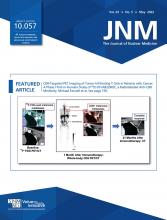TO THE EDITOR: An excellent recent review by Sgouros et al. on the multifaceted complexities of tumor dose–response was highly informative (1). However, it did not address a practical aspect—how to routinely implement tumor dosimetry in the context of today’s stifling economic mantra of “cheaper, better, faster.” The fine balancing act between clinical needs and health-care economics is an everyday challenge in any busy clinic. But there is hope, in the form of single–time-point dosimetry as a compromise for resource-intensive multiple–time-point imaging.
Previous work by Hänscheid et al. on single–time-point dosimetry works well for normal organs, but its application to metastases is questionable because of widely heterogeneous tumor biology (2). Tumors are, by definition, inherently abnormal. Therefore, the effective half-life (Teff) of any tumor type will have a wide spread of values. This means that a single average Teff defined for a tumor type might not be sufficiently personalized to an individual patient.
An alternative framework for single–time-point tumor dosimetry is proposed here to complement that by Hänscheid et al. (2). It assumes a normal distribution of tumor Teff around its mean and uses ±1 SD to rationalize tumor Teff values for faint (poor), mild (weak), moderate (good), and intense (excellent) tumor avidity. Whichever method of single–time-point tumor dosimetry the user eventually chooses will depend on whether each method’s assumptions are reasonably valid for the patient at hand.
To illustrate this alternative method, let us consider 131I-avid bone metastases from differentiated thyroid cancer. For this exercise, it is necessary to quote preliminary data. From a very small dataset of 8 bone metastases by 2 studies (6 lesions) and 2 lesions from our own data, the mean tumor Teff in 131I-avid bone metastasis prepared by thyroid hormone withdrawal was approximately 4.07 ± 2.52 d (3,4). Its wide SD reflects the highly heterogeneous biology of metastases.
Next, we invoke the central-limit theorem to assume a normal distribution of tumor Teff around its mean. This assumption is obviously false in the current example of only 8 lesions but will eventually trend closer to the truth with future additional data. Within this normal distribution framework, bone metastases that are visually assessed to have faint 131I avidity will be to the left of −1 SD (Teff, <1.55 d), mild avidity will be at −1 SD (Teff, 1.55 d), moderate avidity will be at the mean (Teff, 4.07 d), and intense avidity will be at +1 SD (Teff, 6.59 d). The visual classification of 131I avidity may be referenced to the liver, analogous to the Krenning score (5).
Lesion mass is measured by sectional volumetry. Lesion activity at time t (d) after administration of 131I is measured by calibrated scintigraphy. Finally, the tumor-absorbed dose (Gy) may be calculated by the method described by Jentzen et al., which assumes a linear initial time–activity concentration rate and a time to peak tumor uptake of 8 h, followed by monoexponential clearance in accordance with tumor Teff (6). This alternative method of single–time-point dosimetry could also be applied to 131I-avid soft-tissue metastases, with preliminary data suggesting that the mean tumor Teff prepared by thyroid hormone withdrawal could be approximately 2.55 ± 0.35 d (7,8).
Footnotes
Published online Dec. 21, 2021.
- © 2022 by the Society of Nuclear Medicine and Molecular Imaging.







